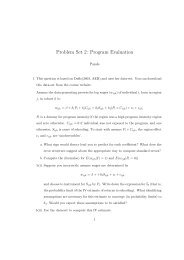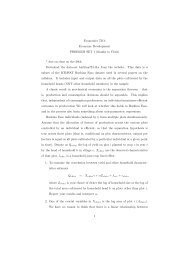The Expected Utility Model: Its Variants, Purposes, Evidence and ...
The Expected Utility Model: Its Variants, Purposes, Evidence and ...
The Expected Utility Model: Its Variants, Purposes, Evidence and ...
You also want an ePaper? Increase the reach of your titles
YUMPU automatically turns print PDFs into web optimized ePapers that Google loves.
Schoema ker: <strong>The</strong> <strong>Expected</strong> <strong>Utility</strong> <strong>Model</strong><br />
b. Types of Cardinal <strong>Utility</strong><br />
As Peter Fishburn (1976) has noted, the<br />
concept of cardinal utility has psychological,<br />
empirical as well as measurement-theoretic<br />
aspects which together with such<br />
related terminology as "measurable," "additive,"<br />
"determinate," "intensive," <strong>and</strong><br />
"linear" utility has given rise to considerable<br />
confusion as to its precise meaning.<br />
<strong>The</strong> term "cardinal utility" goes back to<br />
John R. Hicks <strong>and</strong> R. G. D. Allen (1934)<br />
who argued that only ordinal preference<br />
was needed in economic theory, thereby<br />
dispensing with neoclassical utility (Vivian<br />
Walsh, 1970). Cardinal utility in the neoclassical<br />
context refers to strength of preference,<br />
i.e., to statements about intensity<br />
as well as direction of preference. From<br />
a measurement-theoretic viewpoint, cardinal<br />
utility has a rather different meaning,<br />
referring to the allowable transformations<br />
of the underlying measurement<br />
scale. If the scale is unique up to at least<br />
linear transformation, it constitutes cardinal<br />
or so-called strong measurement<br />
(S. S. Stevens, 1946). Common examples<br />
are temperature <strong>and</strong> weight measures<br />
which constitute interval <strong>and</strong> ratio scales<br />
respectively. From a measurement perspective<br />
NM utility theory is cardinal in<br />
that its utility scale has interval properties.<br />
However, from a preference perspective,<br />
NM utility theory is ordinal in that it provides<br />
no more than ordinal rankings of<br />
lotteries.<br />
<strong>The</strong> cardinal nature of NM theory must<br />
thus be interpreted carefully. Even<br />
though NM utility functions are interval<br />
scales, implying that the ratios of utility<br />
differences are invariant under linear<br />
transformations, it does not follow that if<br />
xi >x2 >x3 >x4 <strong>and</strong> u(xi) - 4x2) > u(xi<br />
- u(x~), the change from x2 to xl would<br />
be more preferred than the change from<br />
X4 to X3 puncan L~~~<strong>and</strong> iff^, 1957,<br />
32). Thus NM not be interpreted<br />
as measuring strength of prefer-<br />
ence under certainty, being quite different<br />
in this regard from neoclassical<br />
cardinal utility (George Stigler, 1950).6<br />
One reason is that preferences among lotteries<br />
are determined by at least two separate<br />
factors; namely (1)strength of preference<br />
for the consequences under<br />
certainty, <strong>and</strong> (2) attitude toward risk. <strong>The</strong><br />
NM utility function is a compound mixture<br />
of these two, without direct resort<br />
to interval comparisons or strength of<br />
preference measures. As a preference theory,<br />
it is wholly ordinal. Nevertheless it<br />
implicitly assumes that a neoclassical type<br />
of utility exists, otherwise it would not be<br />
possible psychologically to determine the<br />
certainty equivalence of a lottery. An interesting<br />
analysis as to the connection between<br />
ordinal <strong>and</strong> cardinal utility was offered<br />
by Eugene Fama (1972). Since some<br />
economists consider intensity of preference<br />
meaningless (Charles Plott, 1976, p.<br />
541), putatively because it cannot be measured<br />
from revealed preferences, it merits<br />
closer examination.<br />
One approach is to view strength of<br />
preference as an intuitive psychological<br />
primitive. For instance, most people<br />
would consider it meaningful to say that<br />
the increase in pleasure due to adding<br />
milk to one's coffee is of a lower magnitude<br />
than the pleasure increment associated<br />
with a sizable salary raise. Similarly,<br />
someone might note that the last hour on<br />
some trip was more tiring than the first.<br />
Indeed, in psychological scaling experiments<br />
subjects routinely make interval<br />
comparisons involving such quantities as<br />
loudness, weight, temperature, <strong>and</strong><br />
brightness (Stevens, 1957). Usually, subjects'<br />
perceptions of the interval differ-<br />
s Consequently, the notion of marginal utility has<br />
a rather Merent meaning in NM theory as well.<br />
In classical economics marginal utility refers to pleasure<br />
increments under certainty. In NM theory it<br />
refers to "the marginal rate of substitution between<br />
x <strong>and</strong> the probability of winning the prespecified<br />
prize of the st<strong>and</strong>ard lottery ticket" (Baumol, 1972,<br />
p. 548).




